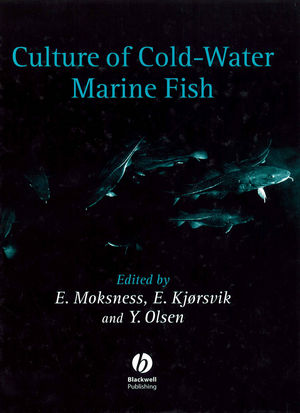Culture of Cold-Water Marine FishISBN: 978-0-85238-276-9
Hardcover
544 pages
January 2004, Wiley-Blackwell
 |
||||||
List of Contributors.
1 Introduction (The Editors).
1.1 References.
2 Abiotic Factors (B.R. Howell and S.M. Baynes).
2.1 Introduction.
2.2 Oxygen and oxygen consumption.
2.3 Ammonia.
2.4 Temperature.
2.5 Salinity.
2.6 Hydrogen sulphide.
2.7 Light.
2.8 Algae blooms.
2.9 Site selection.
2.10 References.
3 Microbial Interactions, Prophylaxis and Diseases (O. Vadstein, T.A. Mo and O. Bergh).
3.1 Fish–microbe interactions and implications in aquaculture.
3.2 Viral diseases: diagnosis.
3.3 Bacterial diseases: diagnosis.
3.4 Parasitic protists and metazoans: diagnosis, prophylaxis and treatment.
3.5 A strategy for microbial control.
3.6 Improving environmental conditions.
3.7 Improving the resistance of the fish.
3.8 Closing remarks.
3.9 References.
4 Live Food Technology of Cold-Water Marine Fish Larvae (Y. Olsen).
4.1 Introduction.
4.2 Cultivation systems.
4.3 Production of rotifers.
4.4 Production of Artemia.
4.5 Marine copepods.
4.6 Concluding remarks.
4.7 References.
5 Brood Stock and Egg Production (D. Pavlov, E. Kjorsvik, T. Refsti and O. Andersen).
5.1 Reproductive strategies.
5.2 Gonad maturation.
5.3 Brood-stock management and egg production.
5.4 Egg quality.
5.5 Sperm production and quality.
5.6 Selective breeding.
5.7 Modern biotechnology and aquaculture.
5.8 References.
6 From Fertilisation to the End of Metamorphosis—Functional Development (E. Kjorsvik, K. Pittman and D. Pavlov).
6.1 Intervals of fish ontogeny and definitions of the organism.
6.2 Egg classification.
6.3 Insemination and fertilisation.
6.4 Embryonic development and hatching.
6.5 From hatching to metamorphosis.
6.6 Functional development of organ systems from hatching to metamorphosis.
6.7 Hatchery design.
6.8 Critical aspects of larval cultivation.
6.9 References.
7 First Feeding Technology (Y. Olsen, T. van der Meeren and K.I. Reitan).
7.1 Introduction.
7.2 Nutritional requirements of marine fish larvae.
7.3 Definitions and system description.
7.4 Larval rearing in 'nature-like systems'.
7.5 Larval first feeding in intensive systems.
7.6 Concluding remarks.
7.7 References.
8 Weaning and Nursery (J. Stoss, K. Hamre and H. Ottera).
8.1 Introduction.
8.2 Developmental aspects of digestion in marine fish larvae.
8.3 Nutrition.
8.4 Microparticulate diets.
8.5 Weaning and nursery stage, practical aspects.
8.6 References.
9 On-Growing to Market Size (M. Jobling).
9.1 Introduction.
9.2 Analysis of feeds and feedstuffs.
9.3 Protein requirements and sources.
9.4 Lipids and lipid requirements.
9.5 Carbohydrates.
9.6 Micronutrients: vitamins and minerals.
9.7 Feed types and formulations.
9.8 Feeding regimes and practices.
9.9 Growth and feed conversion.
9.10 Nutrient deposition and body composition.
9.11 Concluding comments.
9.12 References.
10 The Status and Perspectives for the Species (T. Svasand, H.M. Ottera, G.L. Taranger, M. Litvak, A.B. Skiftesvik, R.M. Bjelland, D.A. Pavlov, J.Chr. Holm, T. Harboe, A. Mangor-Jensen, B. Norberg and B. Howell).
10.1 Atlantic cod.
10.2 Haddock.
10.3 Hake.
10.4 Wolf-fish.
10.5 Halibut.
10.6 Turbot.
10.7 Sole.
11 Marine Stock Enhancement and Sea-Ranching (T. Svasand and E. Moksness).
11.1 Introduction.
11.2 Stock enhancement and sea-ranching in Europe and North America.
11.3 Stock enhancement and sea-ranching in Asia.
11.4 Prospects and limitations of enhancement and sea-ranching.
11.5 Recommendations and guidelines.
11.6 References.
12 New Species in Aquaculture: Some Basic Economic Aspects (R. Engelsen, F. Asche, F. Skjennum and G. Adoff).
12.1 Introduction.
12.2 Cod.
12.3 Haddock.
12.4 European hake.
12.5 Wolf-fish.
12.6 Halibut.
12.7 Turbot.
12.8 Sole.
12.9 Conclusions.
12.10 References.
Index.



